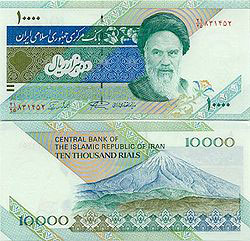Azerbaijan, Baku, Oct. 6 / Trend T.Koyayeva /
Opinions relating the increase in U.S. dollar rate with regard to Iranian rial with the toughened sanctions against Iran may be hasty, the American expert believes.
"There have been spikes in the USD exchange rate with the Iranian rial before," professor at the U.S National Defense University and Georgetown University Paul Sullivan told Trend on his own via e-mail." Lots of people are saying this spike is due to the new sanctions. I think they may be jumping to conclusions on this by saying it is only due to the increased sanctions, which are not as harsh an incremental increase in sanctions as one might think by reading the press."
The national currency of Iran- rial fell by nearly 21 percent against the dollar last week. Economists believe that the reason for the unexpected collapse of the currency rate is the cumulative effect of sanctions imposed on Iran by various countries and international organizations over Iran's nuclear program, as well as lack of investment followed by an infusion of capital into the Iranian economy.
Two weeks ago, the dollar could be bought for 10,500 rials, whilst now it worth 12,500. It reached 13,000 during the week.
Moreover, a sharp increase is observed in rates of other world currencies.
Sullivan said the sanctions may be seen by currency traders with Iran and outside of Iran as maybe the tipping point, but that may turn out to be wrong.
There could also be some speculators inside and outside of Iran looking to make some quick money on the increased sense of risk associated with the rial, he said.
"It is a bit odd that the exchange rate for the rial stayed so constant relative to the dollar given that Iran has been through some very tough inflationary times since the Iranians turned to a managed float exchange system in Iran, while the U.S. has had stable and low inflation," Sullivan said.
The Central Bank of Iran has been maintaining a system of "floating exchange rate" since 2001, which aims to curb the devaluation of the rial below a certain level, but not the official rate. Under this system, the course can be managed floating and independent floating.
Prior to this, Iran was applying a system of "multiple exchange rate", which uses various rates of national currency for different types of currency operations, the participants in these transactions and the currencies.
According to Sullivan, given the wide swings in the value of oil over those years one should have also seen more swings in the currency if it was truly a 'managed float'.
"This could easily lead to the obvious conclusion that the Iranian Central Bank has been heavily controlling the value of the rial at times of stress on the currency, but for some reason seemed to drop the ball this time," he said.
It could be, Sullivan said, a temporary lack of reserves to keep pumping up the rial or it could be a long term systemic problem with the rial. It could even be an odd way for the rial to be devalued by the Central Bank without admitting that is what it is doing.
The Central Bank of Iran says it will stabilize the currency and bring the value back up again this week," he said. "This also seems a bit dubious. I wonder how they are going to do that quickly and sustainably."
If depreciation of the rial will continue, then "we may have an interesting set of economic reactions to the change in the value of the rial, such as increased non-oil exports from Iran, but also a possible increase in inflation in Iran due to how many of its products it will be importing at a lowered exchange rate," Sullivan said.
Real is the national currency of Iran since 1932. Rial replaced tumen after the monetary reform on the same year. Until recently, increase in rate of the U.S. dollar against the Iranian rial ranged between 9,500-10,000 rials and euros - about 14,000.
Do you have any feedback? Contact our journalist at [email protected]






